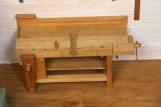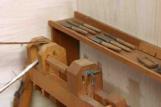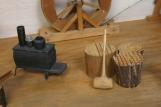14
LIME KILNLime was needed by the settler for mixing with sand to chink the early log homes. The kilns were often built into the side of a hill or small elevation. A kiln was quite large - about 15 feet in diameter and had to be line with a thick wall of mortar and stone that would not crack with intense hear. The bottom of the kiln was concave and about a foot above the base of the kiln, an opening was left for stoking the fire. Lime would also be removed through this opening. Flat stones were placed in the bottom of the kiln and limestone was placed on these stones. The fire was stoked and had to be kept burning day and night. It took several days for the kiln to reach a sufficient heat and then took virtually as long to cool down. Once cool, the lime was removed.
The kiln would be stoked with wood that was unsuitable for construction and it took a great quantity of wood to bring the heat up sufficiently to extract the lime.
16
CABINET SHOPJohn McCrea Sr. was a cabinetmaker: a builder of furniture. He also built pine coffins ($5.00) in which to bury the dead. All articles were hand made. The only piece of furniture was a lathe for wood turning, which was operated by a horsepower engine located in the yard of the shop.
In this model can be seen the driving wheel for the lathe, a cabinet maker's bench with tools hanging above it (including cramps, mitre board and box, saw, draw-knife and straight edge), a stove with a glue pot resting on top, basswood blocks for making chairs, and a saw horse with a table top being glued and cramped. The shop has all the items and is ready for the cabinet maker to ply his craft.
18
CABINET SHOP - WORKBENCHThe detail on the work bench is exact and includes the wood vise.
20
CABINET SHOP - LATHE & CHISELSThe various sizes of chisels were modeled by McCrea and lay on a shelf above the lathe.
The lathe is powered by a belt from the driving wheel.
22
CABINET SHOP - STOVE & GLUE POTSA small woodstove was used in the cabinet shop not only for heat but also for heating the glue used in the furniture production. The glue pots are on top of the stove. Each of these was crafted in correct proportion and true to the original. By the stove are three stumps and a mallet.
24
CABINET SHOP FINISHING ROOMHere the chairs and tables and other household furnishing were made. The picture shows several chairs, kitchen chair, an armchair, highchair, stool as well as a drop leaf table. In the foreground is what would be considering a "better' coffin, that is one with a removable lid to disclose the face of the departed. The attention to detail includes the decorative lining of the coffin. A form in which hair mattresses were filled stands against the wall. In front of this form is a standard or ordinary plain coffin.
26
CABINET SHOP - CHAIR BEING FINISHEDA chair sits on a board between two sawhorses, ready to have the finishing touches, perhaps a coat of stain. Nearby is the workbench with the tin containers holding the stains, varnishes, turpentine, oil and shellac. The base of a corner cupboard is behind the workbench and is of the style of the Canadian pioneer era.






